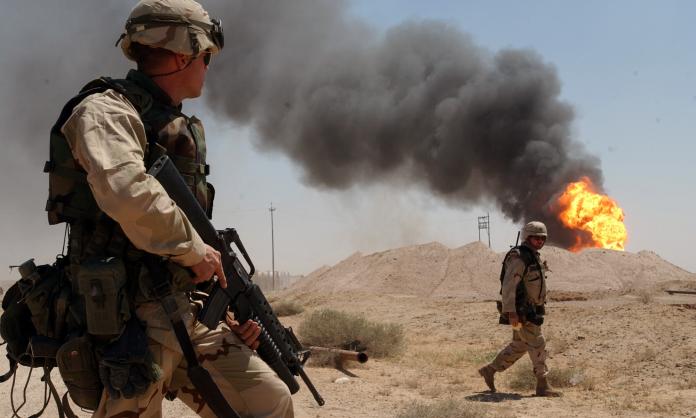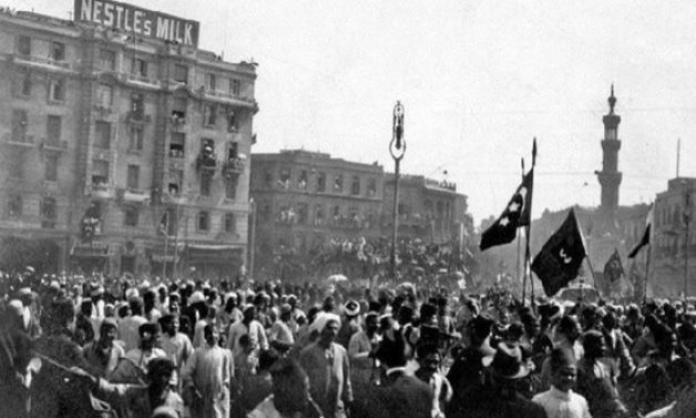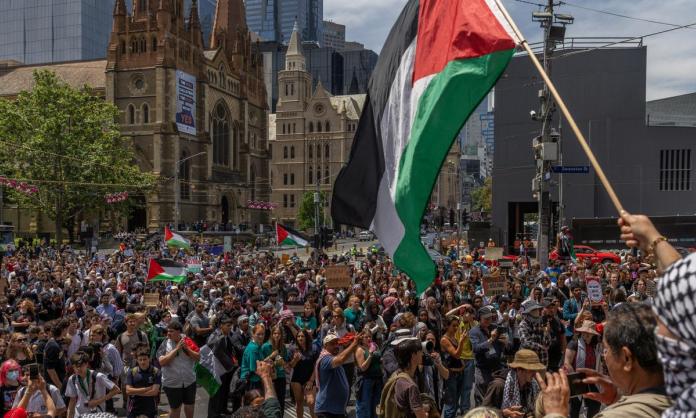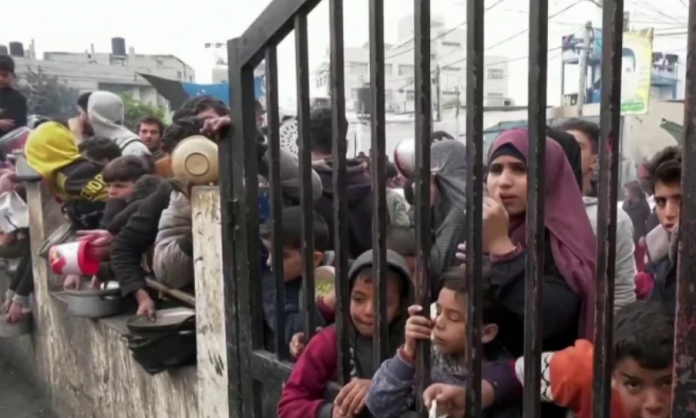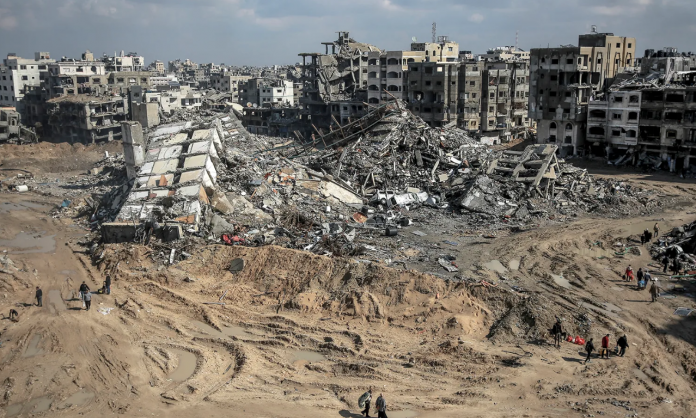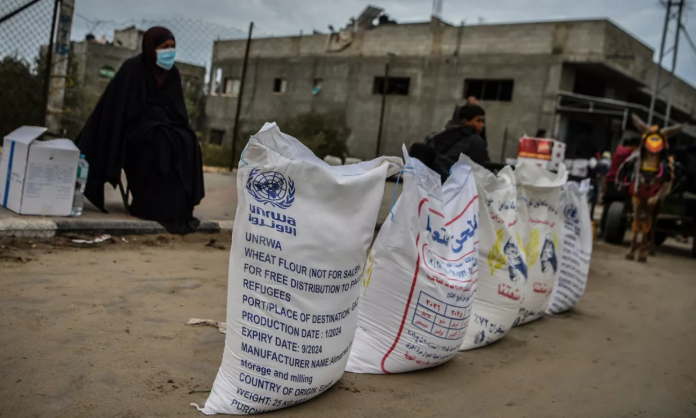The US is using the opportunity created by Russia’s invasion of Ukraine to promote itself as a champion of national sovereignty, democracy and human rights. In his State of the Union address on 2 March, US President Joe Biden was cheered by both sides of Congress as he set out the US’s claims to higher purpose: “We fought for freedom, expanded liberty, defeated totalitarianism and terror. We built the strongest, freest and most prosperous nation the world has ever known”. In relation to the invasion of Ukraine:
“Now is the hour. Our moment of responsibility. Our test of resolve and conscience, of history itself ... I know this nation will meet the test. To protect freedom and liberty, to expand fairness and opportunity. We will save democracy.”
It’s nice that large countries invading small countries is now self-evidently morally outrageous. Pity that wasn’t the case before the US launched the two largest invasions so far this century, first in Afghanistan in 2001 and then in Iraq in 2003. Just like Russia, the US is up to its elbows in the blood of its innocent victims, their lives destroyed by brutal invasions and occupations justified by lies.
Within weeks of the 11 September 2001 terrorist attacks on New York and Washington, the George W. Bush administration had invaded Afghanistan, despite the Taliban offering to hand over Osama bin Laden. As Biden is doing today, Bush cloaked the US mission in democratic rhetoric: “Freedom and fear are at war. The advance of human freedom, the great achievement of our time and the great hope of every time, now depends on us”.
Unlike the moral outrage in response to Russia’s invasion today, there was widespread support for the invasion of Afghanistan. The Democrats backed it, as did many US allies, including Australia. The media, both populist and “serious”, such as the New York Times, threw their full support behind it. Small-l liberals also backed up the propaganda. Many prominent American feminist organisations supported the war on the basis that the US could liberate Afghan women from Taliban rule.
The invasion was overwhelmingly popular within the US, and in Australia too. The few opponents of what the White House called the “War on Terror” were accused of being terrorist sympathisers. It was left to small groups of socialists and other committed anti-imperialists to forcefully carry the arguments against the build-up to war.
On 7 October 2001, the US Air Force conducted the first air strikes, followed by deployment of US ground troops in what the White House called “Operation Enduring Freedom”. Within weeks, the Taliban had been overthrown and its leaders killed or forced to flee to rural hideouts or neighbouring Pakistan.
The invasion and eight-year occupation of Iraq came soon after. The White House claimed that Iraqi leader Saddam Hussein represented an existential threat to the world because his regime possessed weapons of mass destruction: anthrax, nerve gas and nuclear weapons. The administration also sought to link Saddam Hussein to 9/11, saying that the Iraqi president was in league with al-Qaeda. The enemy was clear, Bush argued: “States like these and their terrorist allies constitute an axis of evil, arming to threaten the peace of the world”.
The media took Bush’s cue, and newspapers in the US, Europe and Australia were filled with articles calling Hussein “the new Hitler”, listing his crimes against his own people and describing in great detail the supposed threat he posed to the world. General Colin Powell, US secretary of state, argued that it was only a matter of time before Hussein used his weapons of mass destruction against the world.
The US was much less successful in convincing the US population and the rest of the world that it was justified in invading Iraq. Claims that the US was bringing “freedom” and “democracy” to the Middle East were being increasingly exposed by the reality of the US occupation in Afghanistan.
In February 2003, millions of people took part in worldwide demonstrations against the US invasion, the biggest anti-war protests in history. The US could not even win the support of many other governments, unlike after 9/11. Not just the Russian and Chinese governments opposed its plans; so too did the French and German, stymieing US plans to get UN cover for its invasion.
Tragically, the anti-war demonstrations were not enough to stop the war, and the US was able to cobble together support from Britain, Australia and a few others to form a “coalition of the willing”.
On 20 March, the invasion began. The US launched hundreds of cruise missiles, flew 18,000 sorties, dropped 50 cluster bombs and discharged 12,000 precision guided missiles. In just three weeks, coalition forces had taken Baghdad, forcing Hussein to flee. By the end of April, more than 200,000 American and British soldiers occupied the country. On 1 May, Bush declared hostilities over and “mission accomplished”. Former diplomat Paul Bremer was appointed pro-consul of Iraq, reporting to the White House.
The claims of those who had stood against the invasion of Afghanistan as well as the much larger number who had opposed the war with Iraq have been tragically vindicated by the record of the US invasion and occupation of these two countries.
Far from helping the people of Afghanistan, the US only caused more misery. It promised liberation, but instead imposed a government led by the warlords of the Northern Alliance, who were, if anything, more brutal than the Taliban.
And far from bringing peace and stability, Western forces committed atrocities against combatants and civilians. The 2020 Brereton Report revealed systematic war crimes on the part of Australian special forces in Afghanistan, including the murder of 39 civilians and prisoners, the desecration of corpses and planting of evidence.
Prisoners seized in Afghanistan and Pakistan were transported to the Guantánamo Bay prison in US-held territory in Cuba, where they were treated horrifically, shackled hand and foot and held for years without trial or with only military kangaroo courts passing judgement. Others seized by US occupying forces were held prisoner in so-called black sites in North Africa and elsewhere, where they were tortured on behalf of the US.
The death toll from the war and occupation reached a minimum of 200,000, including 50,000 civilians. This does not include those who died from disease, loss of access to food and water and the devastation of infrastructure. Those who survived experienced endless warfare, the deaths of loved ones and crumbling infrastructure. Afghan women were not liberated. The US-backed warlords continued to repress women’s rights.
When the US pulled its remaining forces out last year, the puppet regime it had installed was thrown out quickly and without a fight by the resurgent Taliban.
The cost of US invasion was higher still for the people of Iraq. Like Afghanistan, Iraq was already in a desperate state before the US invasion. Hundreds of thousands died, and health, education, infrastructure and power supply were already substantially degraded as a result of US sanctions imposed following the 1991 Gulf War.
The invasion unleashed more brutality. US and British forces conducted sweeps of neighbourhoods suspected of loyalties to the regime, arresting thousands. Workers who had joined Saddam Hussein’s Baath Party as a condition of their employment were sacked by the US. The 450,000-strong army was dissolved, throwing many, Sunni and Shia alike, into poverty.
Within months, a non-sectarian resistance movement formed to push the US out. But there was no support forthcoming like there rightly has been for the Ukrainian resistance. Instead, it was brutally crushed. In Fallujah, a centre of the resistance, Australian General Jim Molan (later a Liberal MP) led the coalition armed forces raining terror on the town, killing thousands, fighters and civilians alike.
Resistance fighters taken captive by the occupation forces were imprisoned in the notorious Abu Ghraib prison. In February 2004, a US military inquiry confirmed that “numerous incidents of sadistic, blatant, and wanton criminal abuses were inflicted on several detainees” there. While some soldiers directly involved in the abuse were charged, the higher-ups who were just as culpable got off scot-free, and the subsequent Military Commissions Act of 2006 made it virtually impossible for detainees to challenge crimes committed against them.
Shocked by the resistance at Fallujah, the US ramped up divide-and-rule tactics, playing up divisions between the Shia and Sunni sections of the population and playing off both against the Kurds. The result was virtual civil war in 2006-07. Tens of thousands of Iraqis died in sectarian violence in this period. The US was increasingly holed up in its Green Zone, a highly fortified area of Baghdad incorporating what became the largest US embassy building in the entire Middle East, from which it directed operations.
Eventually, the Iraqi government of Nouri Al-Maliki turned against the US. In 2011, it refused to give the US troops legal immunity, forcing the US to dismantle its largest military base in the Middle East as it scuttled out of the country in December 2011. The eight-year occupation had cost anything from 200,000 to half a million lives.
It was not just Afghans and Iraqis who suffered from the Bush administration’s War on Terror. The administration also used the threat of terrorism to carry out a sustained attack on civil liberties at home and to whip up racism against Muslims. Mosques were firebombed. Women had their head scarves ripped off. The Indian and Chinese governments followed suit, targeting their Muslim minorities in Kashmir and Xinjiang, using the very same War on Terror rhetoric and demonisation of Muslims.
The US working class also bore the horrendous financial cost of two decades of wars and occupations. The US government spent more than $1 trillion on the invasion and two-decade occupation of Afghanistan and $2 trillion on the war in Iraq. This was money that could otherwise have been spent on education, health and social welfare of workers, pensioners, students and the poor.
And then there was the cost to the armed forces themselves. All told, 7,000 US service members died in the two wars and occupations. Tens of thousands were injured and more again suffered mental and psychiatric disorders as a result of their military service, often with punishing consequences for their families.
The US-led invasions and occupations of Afghanistan and Iraq demonstrate that its claims to be a champion of democracy and human rights are a sick joke. Its condemnation of Russia for invading Ukraine is rank hypocrisy. The very same people who justified the wars in Afghanistan and Iraq are now condemning Russia for doing the same. When Condoleezza Rice, who served as George W. Bush’s national security adviser in his first term in office, told Fox News soon after Russia’s invasion of Ukraine in February: “When you invade a sovereign nation, that is a war crime”, the duplicity was laid bare.
Today, the US is not trying to whip up enthusiasm at home or abroad to go to war with Russia—although, given the steady escalation of US involvement in the current conflict, this cannot be ruled out. But in the meantime, it can pose as peace loving and horrified by violence, apparently without any awareness of the irony.
But every imperialist power has an eye to the next war to secure its interests and power. For the US, this means war with China at some point. The Biden administration is using Russia’s invasion as an opportunity to rally US allies in preparation for a future war with China. We can be fairly certain that in the event of such a war, the US will reach for similar excuses as it did in the early 2000s. It will say that it is defending democracy, that it is protecting small nations, that is stopping authoritarian regimes from trampling the rights of others. Its record should make it clear these are nothing but lies.




